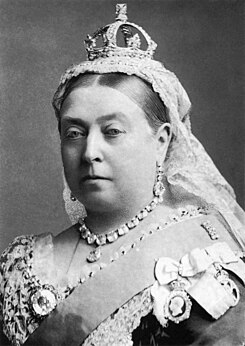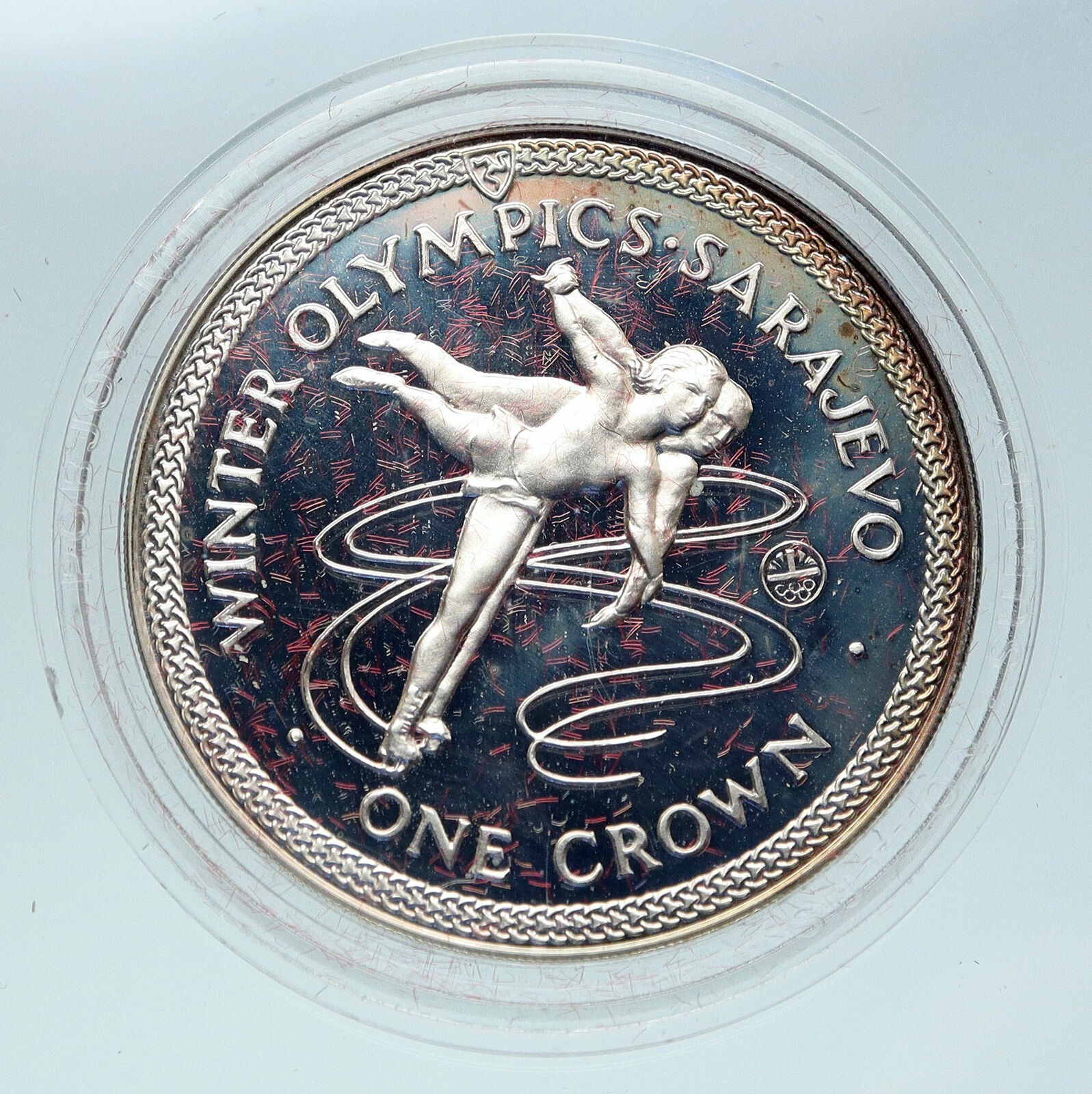|
Isle of Man – Ruled by Victoria I: 20 June 1837 – 22 January 1901
1839 Copper 1/2 Penny 28mm (9.24 grams)
Reference: KM# 13
VICTORIA DEI GRATIA, Bust of young Victoria facing left surrounded by legend.
STABIT QVOCVNQVE IECERIS, Triskelion surrounded by legend.
You are bidding on the exact item pictured, provided with a Certificate of Authenticity and Lifetime Guarantee of Authenticity.
A triskelion or triskele (which invariably has rotational symmetry) is a motif consisting of three interlocked spirals, or three bent human legs. Both words are from Greek “τρισκέλιον” (triskelion) or “τρισκελής” (triskeles), “three-legged”, from prefix “τρι-” (tri-), “three times” + “σκέλος” (skelos), “leg”. Although it appears in many places and periods, it is especially characteristic of the Celtic art of the La Tène culture of the European Iron Age.
A triskelion is the symbol of Sicily, where it is called trinacria, as well as of the Isle of Man, Brittany and the town of Füssen in Germany.

The flag of Sicily, featuring the triskelion symbol revived by Joachim Murat
The triskelion symbol appears in many early cultures, including western civilization’s earliest known astronomical calendar at the famous megalithic tomb of Newgrange in Ireland built around 3200 BC, Mycenaean vessels, on coinage in Lycia, and on staters of Pamphylia (at Aspendos, 370-333 BC) and Pisidia. It appears as a heraldic emblem on warriors’ shields depicted on Greek pottery.
Familiar as an ancient symbol of Sicily, the symbol dates back to when Sicily was part of Magna Graecia, the colonial extension of Greece beyond the Aegean. Pliny the Elder attributes the origin of the triskelion of Sicily to the triangular form of the island, the ancient Trinacria (from the Greek tri- (three) and akra (end, limb)), which consists of three large capes equidistant from each other, pointing in their respective directions, the names of which were Pelorus, Pachynus, and Lilybæum.
The Celtic symbol of three conjoined spirals may have had triple significance similar to the imagery that lies behind the triskelion. The triple spiral motif is a Neolithic symbol in Western Europe. It is considered a Celtic symbol but is in fact a pre-Celtic symbol. It is carved into the rock of a stone lozenge near the main entrance of the prehistoric Newgrange monument in County Meath, Ireland. Newgrange which was built around 3200 BCE predating the Celtic arrival in Ireland but has long since been incorporated into Celtic culture.
Victoria (Alexandrina Victoria; 24 May 1819 – 22 January 1901) was Queen of the United Kingdom of Great Britain and Ireland from 20 June 1837 until her death. From 1 May 1876, she had the additional title of Empress of India. Victoria was the daughter of Prince Edward, Duke of Kent and Strathearn, the fourth son of King George III. Both the Duke of Kent and King George III died in 1820, and Victoria was raised under close supervision by her German-born mother Princess Victoria of Saxe-Coburg-Saalfeld. She inherited the throne aged 18, after her father’s three elder brothers had all died, leaving no surviving legitimate children. The United Kingdom was already an established constitutional monarchy, in which the sovereign held relatively little direct political power. Privately, Victoria attempted to influence government policy and ministerial appointments; publicly, she became a national icon who was identified with strict standards of personal morality. Victoria married her first cousin, Prince Albert of Saxe-Coburg and Gotha, in 1840. Their nine children married into royal and noble families across the continent, tying them together and earning her the sobriquet “the grandmother of Europe”. After Albert’s death in 1861, Victoria plunged into deep mourning and avoided public appearances. As a result of her seclusion, republicanism temporarily gained strength, but in the latter half of her reign her popularity recovered. Her Golden and Diamond Jubilees were times of public celebration. Her reign of 63 years and seven months is known as the Victorian era. It was a period of industrial, cultural, political, scientific, and military change within the United Kingdom, and was marked by a great expansion of the British Empire. She was the last British monarch of the House of Hanover. Her son and successor, Edward VII, belonged to the House of Saxe-Coburg and Gotha, the line of his father. was raised under close supervision by her German-born mother Princess Victoria of Saxe-Coburg-Saalfeld. She inherited the throne aged 18, after her father’s three elder brothers had all died, leaving no surviving legitimate children. The United Kingdom was already an established constitutional monarchy, in which the sovereign held relatively little direct political power. Privately, Victoria attempted to influence government policy and ministerial appointments; publicly, she became a national icon who was identified with strict standards of personal morality. Victoria married her first cousin, Prince Albert of Saxe-Coburg and Gotha, in 1840. Their nine children married into royal and noble families across the continent, tying them together and earning her the sobriquet “the grandmother of Europe”. After Albert’s death in 1861, Victoria plunged into deep mourning and avoided public appearances. As a result of her seclusion, republicanism temporarily gained strength, but in the latter half of her reign her popularity recovered. Her Golden and Diamond Jubilees were times of public celebration. Her reign of 63 years and seven months is known as the Victorian era. It was a period of industrial, cultural, political, scientific, and military change within the United Kingdom, and was marked by a great expansion of the British Empire. She was the last British monarch of the House of Hanover. Her son and successor, Edward VII, belonged to the House of Saxe-Coburg and Gotha, the line of his father.
 The Isle of Man, also known simply as Mann, is a self-governing Crown dependency in the Irish Sea between the islands of Great Britain and Ireland. The head of state is Queen Elizabeth II, who holds the title of Lord of Mann. The Lord of Mann is represented by a Lieutenant Governor. Foreign relations and defence are the responsibility of the British Government. The Isle of Man, also known simply as Mann, is a self-governing Crown dependency in the Irish Sea between the islands of Great Britain and Ireland. The head of state is Queen Elizabeth II, who holds the title of Lord of Mann. The Lord of Mann is represented by a Lieutenant Governor. Foreign relations and defence are the responsibility of the British Government.
The island has been inhabited since before 6500 BC. Gaelic cultural influence began in the 5th century and the Manx language, a branch of the Gaelic languages, emerged. In 627, Edwin of Northumbria conquered the Isle of Man along with most of Mercia. In the 9th century, Norsemen established the Kingdom of the Isles. Magnus III, King of Norway, was also known as King of Mann and the Isles between 1099 and 1103.
In 1266, the island became part of Scotland under the Treaty of Perth, after being ruled by Norway. After a period of alternating rule by the kings of Scotland and England, the island came under the feudal lordship of the English Crown in 1399. The lordship revested into the British Crown in 1765, but the island never became part of the Kingdom of Great Britain or its successor the United Kingdom: it retained its status as an internally self-governing Crown dependency.
 Flag Flag  Coat of arms Coat of arms
|






 was raised under close supervision by her German-born mother Princess Victoria of Saxe-Coburg-Saalfeld. She inherited the throne aged 18, after her father’s three elder brothers had all died, leaving no surviving legitimate children. The United Kingdom was already an established constitutional monarchy, in which the sovereign held relatively little direct political power. Privately, Victoria attempted to influence government policy and ministerial appointments; publicly, she became a national icon who was identified with strict standards of personal morality. Victoria married her first cousin, Prince Albert of Saxe-Coburg and Gotha, in 1840. Their nine children married into royal and noble families across the continent, tying them together and earning her the sobriquet “the grandmother of Europe”. After Albert’s death in 1861, Victoria plunged into deep mourning and avoided public appearances. As a result of her seclusion, republicanism temporarily gained strength, but in the latter half of her reign her popularity recovered. Her Golden and Diamond Jubilees were times of public celebration. Her reign of 63 years and seven months is known as the Victorian era. It was a period of industrial, cultural, political, scientific, and military change within the United Kingdom, and was marked by a great expansion of the British Empire. She was the last British monarch of the House of Hanover. Her son and successor, Edward VII, belonged to the House of Saxe-Coburg and Gotha, the line of his father.
was raised under close supervision by her German-born mother Princess Victoria of Saxe-Coburg-Saalfeld. She inherited the throne aged 18, after her father’s three elder brothers had all died, leaving no surviving legitimate children. The United Kingdom was already an established constitutional monarchy, in which the sovereign held relatively little direct political power. Privately, Victoria attempted to influence government policy and ministerial appointments; publicly, she became a national icon who was identified with strict standards of personal morality. Victoria married her first cousin, Prince Albert of Saxe-Coburg and Gotha, in 1840. Their nine children married into royal and noble families across the continent, tying them together and earning her the sobriquet “the grandmother of Europe”. After Albert’s death in 1861, Victoria plunged into deep mourning and avoided public appearances. As a result of her seclusion, republicanism temporarily gained strength, but in the latter half of her reign her popularity recovered. Her Golden and Diamond Jubilees were times of public celebration. Her reign of 63 years and seven months is known as the Victorian era. It was a period of industrial, cultural, political, scientific, and military change within the United Kingdom, and was marked by a great expansion of the British Empire. She was the last British monarch of the House of Hanover. Her son and successor, Edward VII, belonged to the House of Saxe-Coburg and Gotha, the line of his father.  The Isle of Man, also known simply as Mann, is a self-governing Crown dependency in the Irish Sea between the islands of Great Britain and Ireland. The head of state is Queen Elizabeth II, who holds the title of Lord of Mann. The Lord of Mann is represented by a Lieutenant Governor. Foreign relations and defence are the responsibility of the British Government.
The Isle of Man, also known simply as Mann, is a self-governing Crown dependency in the Irish Sea between the islands of Great Britain and Ireland. The head of state is Queen Elizabeth II, who holds the title of Lord of Mann. The Lord of Mann is represented by a Lieutenant Governor. Foreign relations and defence are the responsibility of the British Government. Flag
Flag  Coat of arms
Coat of arms 




